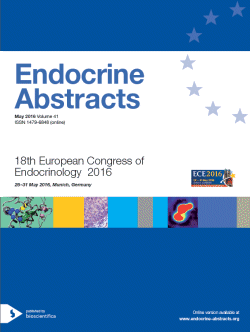Guided Posters
Adrenal
The role of primary cilia in the molecular pathogenesis of phaeochromocytoma
O'Toole Samuel , Srirangalingam Umasuthan , Drake William , Chapple J Paul
Screening for a ten-gene panel in a group of 90 phaeochromocytomas
Sbardella Emilia , Cranston Treena , Mihai Radu , Grossman Ashley
Follow-up of adrenal incidentalomas – are we overdoing it? Follow-up of 145 patients from a single centre
Austin Emily , Miller Ben , Shepherd Lisa , Bates Andrew
The role of immunochemistry in the SDHx mutations in pheochromocytomas and paragangliomas
Angelousi Anna , Georgios Kyriakopoulos , Pavlos Constantinou , Georgios Zografos , Georgios Piaditis , Theodosia Xoreutaki , Dimitra Rontogianni , Gregory Kaltsas
Improvement of bone turnover markers and bone mineral density following treatment of primary aldosteronism
Heng Loh Huai , Kamaruddin Nor Azmi , Sukor Norlela
Dissociation of subtype diagnosis by various criteria on adrenal venous samplings in primary aldosteronism
Ichijo Takamasa , Harada Marina , Ohira Akeo , Miyashita Naoko , Kanaguchi Momoko , Yamashita Kaoru , Ouchi Hiromi , Higa Mariko
New germline mutation in CACNA1H calcium channel causing primary aldosteronism
Roomp Kirsten , Grzyb Kamil , Wolf Cristina , Rhayem Yara , Oliver Nuria , Wardas Barbara , Beck Andreas , Pico Antonio , Beuschlein Felix , Skupin Alexander , May Patrick , Schneider Jochen G.
Adequate salt intake attenuates mineralocorticoid receptor antagonist-induced hyperkalemia in patients with primary aldosteronism
Fountoulakis Stelios , Papanastasiou Labrini , Piaditis George
Is steroid profiling using LC-MS/MS useful in the diagnostic work-up of primary aldosteronism?
Williams Tracy A. , Lenders Jacques W.M. , Peitzsch Mirko , Dekkers Tanja , Dietz Anna S. , Rump Lars C. , Willenberg Holger S. , Treitl Marcus , Bidlingmaier Martin , Beuschlein Felix , Deinum Jaap , Eisenhofer Graeme , Reincke Martin
ea0041gp10 | Adrenal | ECE2016
PRKACA somatic mutations are rare in aldosterone-producing adenomas.
Rhayem Yara , Perez-Rivas Luis Gustavo , Dietz Anna , Bathon Kerstin , Gebhard Christian , Riester Anna , Mauracher Brigitte , Gomez-Sanchez Celso , Schwarzmayr Thomas , Calebiro Davide , Strom Tim M. , Reincke Martin , Beuschlein Felix




